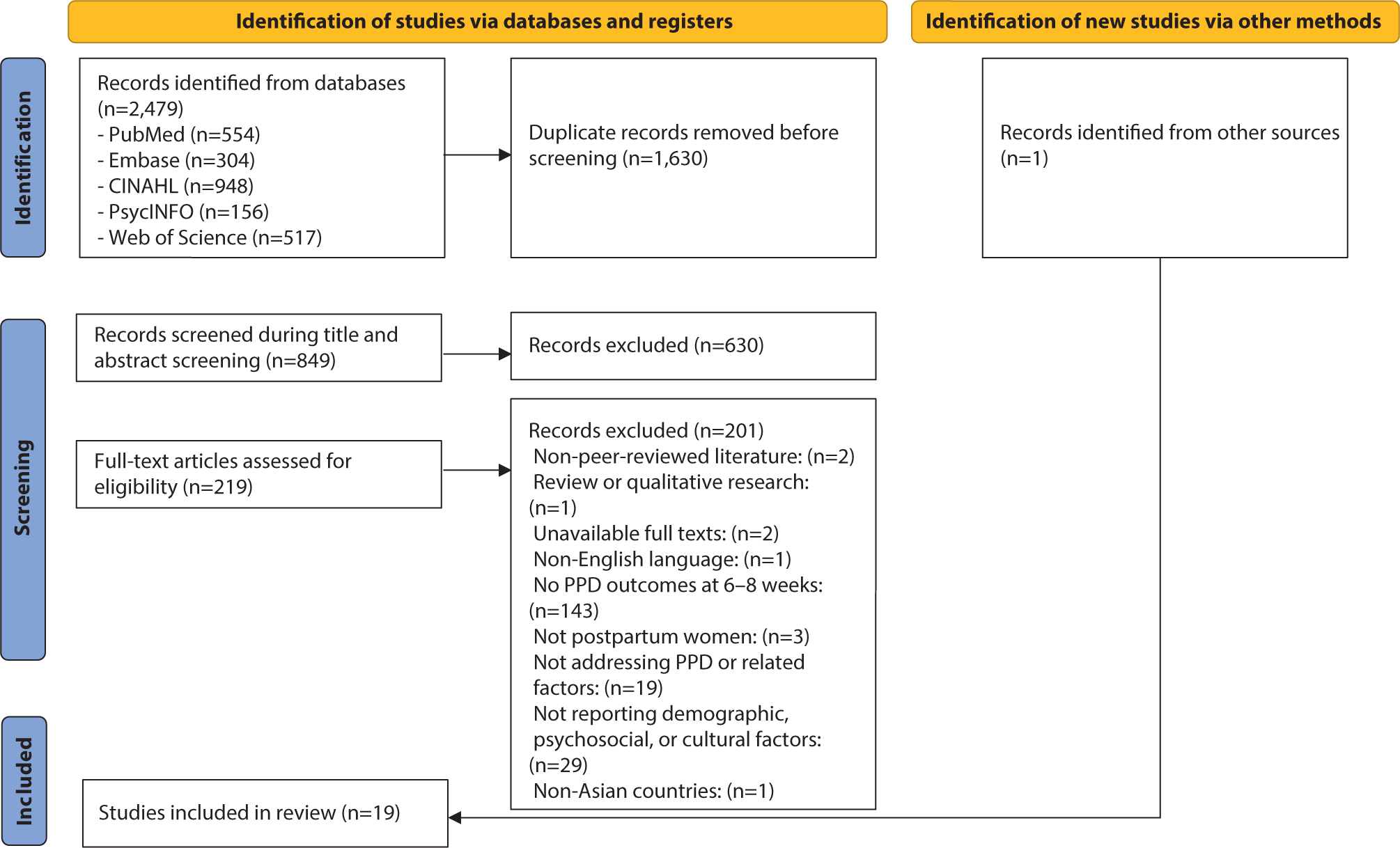
The prevalence of postpartum depression (PPD) in Asia is reported to range from 13.53% to 22.31%. However, there remains a gap in the identification of PPD, particularly regarding cultural cutoff points. Therefore, the purpose of this scoping review was to determine the prevalence and associated factors of PPD in Eastern, South-eastern, Western, and Southern Asian countries and analyze the cutoff points of the Edinburgh Postnatal Depression Scale (EPDS) used across these countries. Following Arksey and O'Malley’s five-step scoping review framework, the population was defined as mothers, the concept as the EPDS, and the context as the Asian region. A literature search was conducted using PubMed, Embase, CINAHL, PsycINFO, and Web of Science. The data analysis focused on demographic characteristics, EPDS cutoffs and features, PPD prevalence, and its associated factors. Nineteen studies were selected. Most countries used translated versions of the EPDS with demonstrated reliability and validity. The cutoff scores varied, with most using scores of 10 or higher. The prevalence of PPD ranged from 5.1% to 78.7%. Key associated factors for PPD included cultural factors such as relationships with in-laws and preferences for the newborn’s sex. To improve the accuracy of PPD screening in Asia, the EPDS should be used consistently, and appropriate cutoff criteria must be established. In addition, prevention strategies and programs that reflect the cultural characteristics and social context of Asia need to be developed for the early detection and prevention of PPD.

The purpose of this study is to investigate the psychological problems in patients with pruritus.
The author compared the anxiety, depression and hostility levels between 47 patients suffering from pruritus and 52 normal controls by means of STAI(State-Trait Anxiety Inventory), BDI(Beck Depression Inventory) and Hostility scales. The subject was the patients with pruritus who visited the dermatology outpatient clinic of Ewha Womans University Mokdong Hospital.
1) The anxiety scale was significantly higher in the female patients with pruritus than in the normal female controls(p<0.01), but there was no significant difference between the male patients and the male controls.
2) There was significant difference in depression scale between the female patients showed a tendency toward higher depression.
3) There was no significant difference in hostility scale between the pruritus patient group and the normal control group.
High levels of anxiety and depression in pruritus patients, especially female. So the author think it will be necessary to treat psychiatrically those patients with pruritus who seem to be suffering from sort of psychiatric symptoms which can be checked by self-report questionaires.
 , Jin Young Kim
, Jin Young Kim , Jae Sun Ryu
, Jae Sun Ryu , EunHee Ha
, EunHee Ha , Hyesook Park
, Hyesook Park
Although common cold is a major cause of morbidity among university students, studies on the risk factors in relation to physical, social, emotional life styles among university students are limited. We sought to evaluate the effects of life style, depressive symptoms, and social support in common cold among medical school students.
120 medical students were surveyed through a self-reported questionnaire. They were asked to rate the severity of eight respiratory symptoms of the Jackson Criterion during the previous month. The ratings were summed to calculate the total symptom score. Social support was assessed by using Interpersonal Support Evaluation List(ISEL). Depressive symptoms were assessed by using The Center for Epidemiologic studies Depression Scale(CES-D). A score of 16 or higher was used as the cut-off point for high depressive symptoms. Life style factors were also evaluated. that Wilcoxon rank sum test, Kruskal-Wallis test, Chi-square test, and logistic regression test were used.
The symptom score ranged from 0 to 18 and the median was 10 among those who had experienced symptoms. 33(34.4%) had experienced cold during the last month. The social support score ranged from 91 to 156 and the median was 113. The prevalence of high depressive symptoms was 36.7%. Students with lower social support and higher depressive symptoms had higher cold symptom scores, although it was not statistically significant. Students who had evaluated their sleep quality and health status as bad had higher cold symptoms scores. In multiple logistics regression analysis, depression, sleep quality, and self-perceived health status were either significant or border-line significant risk factors of cold.
Our study suggests that life style factors such as sleep quality and self-perceived health status is associated with an increased susceptibility to common cold.

Primary depression with cognitive impairment, referred to as depressive pseudodementia, may be mistaken for a progressive degenerative dementia. Recognition of primary depression is clinically important because of its treatability.
To differentiate depression from degenerative dementia, author rsed brain Tc 99m-HMPAO SPECT. By the result the regionar cerebral blood flew(rCBF) in elderly depressed patient was decreased in the left temporoparietal cortex. The pattern of rCBF was different from that of dementia which shows decreased rCBF in bilateral cortex.
By using brain SPECT in depressed elderly patient with cognitive impairment, the discrimination from dementia will be more effective and accurate.

